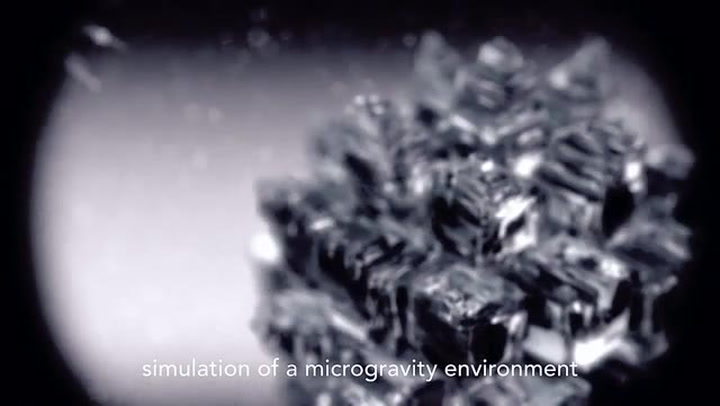Improving Drug Development Through Space-Grown Crystals

Table of Contents
The Unique Advantages of Microgravity Crystal Growth
Crystal growth on Earth is hampered by gravity. Sedimentation and convection currents cause imperfections, limiting crystal size, uniformity, and ultimately, purity. These imperfections can significantly affect drug efficacy and bioavailability. However, the microgravity environment of space offers a unique solution. The absence of these gravitational forces allows for the growth of larger, more uniform, and higher-quality crystals.
- Reduced defects lead to improved drug purity: In microgravity, the absence of sedimentation prevents the accumulation of impurities within the growing crystal lattice, resulting in significantly purer drug substances. This is particularly crucial for complex biomolecules.
- Larger crystal size enhances analysis and processing: Larger crystals are easier to analyze using techniques like X-ray diffraction, crucial for understanding their structure and properties in pharmaceutical crystallography. Larger size also simplifies downstream processing and purification.
- Improved crystal structure can boost drug efficacy and bioavailability: The improved structural integrity of space-grown crystals can directly translate to enhanced drug efficacy. Better crystal structure can improve solubility and absorption, leading to better bioavailability and therapeutic applications.
This contrasts sharply with terrestrial protein crystallization, which often struggles with these limitations. Space-based drug manufacturing offers a pathway to overcome these challenges, paving the way for significantly improved pharmaceutical products. The techniques used for space-based crystal growth are advancing the field of pharmaceutical crystallography and opening new doors in protein crystallization research.
Applications of Space-Grown Crystals in Drug Discovery and Development
The implications of space-grown crystals extend across various facets of drug discovery and development. While still in its early stages, the technology holds immense promise.
- Improved protein crystallization for understanding drug targets: Many drugs target specific proteins within the body. High-quality crystals grown in space provide clearer images for structural analysis, aiding in the design of more effective drugs.
- Enhanced production of pharmaceutical materials: Space-grown crystals could lead to the production of higher-quality pharmaceutical materials, leading to more consistent and effective medications. This is particularly relevant for biopharmaceuticals, which are often difficult to produce in large quantities with high purity on Earth.
- Development of novel drug delivery systems: The unique properties of space-grown crystals could enable the development of novel drug delivery systems with improved efficacy and reduced side effects. This could significantly benefit patients by providing more targeted and efficient therapies.
The advancements in biopharmaceutical development driven by space-grown crystals offer significant opportunities within pharmaceutical research. The potential therapeutic applications are vast and hold promise for addressing unmet medical needs.
The Role of International Space Stations and Private Space Companies
The research and development of space-grown crystals rely heavily on the infrastructure provided by both governmental and private entities.
- The International Space Station (ISS) as a key platform for experiments: The ISS provides a stable microgravity environment ideal for conducting controlled crystal growth experiments. Many successful experiments have already been performed aboard the ISS, providing valuable data and insights.
- The involvement of private companies in providing space-based services for crystal growth: Private space companies are increasingly involved in offering services for space-based research, including crystal growth facilities and related technologies. This contributes to making space-based research more accessible.
- The future potential for dedicated space-based pharmaceutical manufacturing facilities: The long-term vision includes dedicated facilities in space specifically designed for large-scale pharmaceutical crystal growth and manufacturing. This would revolutionize the pharmaceutical industry.
This collaborative approach between ISS research and commercial spaceflight is crucial for progressing space-based manufacturing and making it a more viable option for the pharmaceutical industry. The ongoing advancements in microgravity research are paving the way for this future.
Challenges and Future Directions in Space-Based Crystal Growth for Pharmaceuticals
Despite the significant potential, space-based crystal growth for pharmaceuticals faces several challenges.
- High costs associated with space-based research: Launching experiments and equipment into space is expensive, limiting the scale of research and the number of projects undertaken.
- Technological challenges related to crystal handling and return: Safe and efficient handling of crystals in space and their return to Earth for analysis presents significant technological hurdles.
- Scaling up production for commercial applications: Moving from small-scale experiments to large-scale commercial production will require substantial technological advancements and optimization.
Future research directions will focus on developing cost-effective drug development strategies, including more efficient and less expensive launch systems and automated crystal growth processes. Advancements in pharmaceutical technology and advanced materials science will be crucial to overcome these limitations and make space-grown crystals a cost-effective and widely accessible tool for the pharmaceutical industry.
Conclusion
The utilization of space-grown crystals presents a transformative opportunity to enhance drug development by overcoming limitations of terrestrial crystal growth. From improved purity and size to enhanced drug efficacy, space-based crystal growth is paving the way for superior pharmaceuticals. The future of drug development lies in embracing innovative approaches like space-grown crystal technology. Further research and investment in this field will unlock its full potential for creating safer, more effective medicines for patients worldwide. Learn more about the exciting advancements in improving drug development through space-grown crystals and explore the possibilities of this groundbreaking technology.

Featured Posts
-
 Rethinking Middle Management Their Critical Role In Business Performance And Employee Development
May 24, 2025
Rethinking Middle Management Their Critical Role In Business Performance And Employee Development
May 24, 2025 -
 Dancing With The Stars Alix Earle A Gen Z Marketing Masterclass
May 24, 2025
Dancing With The Stars Alix Earle A Gen Z Marketing Masterclass
May 24, 2025 -
 Horoscopo Del 11 Al 17 De Marzo De 2025 Analisis Para Cada Signo
May 24, 2025
Horoscopo Del 11 Al 17 De Marzo De 2025 Analisis Para Cada Signo
May 24, 2025 -
 Annie Kilner Runs Errands After Kyle Walkers Night Out
May 24, 2025
Annie Kilner Runs Errands After Kyle Walkers Night Out
May 24, 2025 -
 Borsa Europa Attenzione Fed Piazza Affari In Attesa
May 24, 2025
Borsa Europa Attenzione Fed Piazza Affari In Attesa
May 24, 2025
Latest Posts
-
 Today Show Host Dylan Dreyer Details Of A Near Disaster
May 24, 2025
Today Show Host Dylan Dreyer Details Of A Near Disaster
May 24, 2025 -
 Dylan Dreyer And Brian Fichera A Look At Their Relationship
May 24, 2025
Dylan Dreyer And Brian Fichera A Look At Their Relationship
May 24, 2025 -
 Dylan Dreyer And The Today Show A Close Call You Wont Believe
May 24, 2025
Dylan Dreyer And The Today Show A Close Call You Wont Believe
May 24, 2025 -
 The Today Show Dylan Dreyers Unexpected Hosting Challenge
May 24, 2025
The Today Show Dylan Dreyers Unexpected Hosting Challenge
May 24, 2025 -
 Dylan Dreyers Health And Fitness Journey A Today Show Success Story
May 24, 2025
Dylan Dreyers Health And Fitness Journey A Today Show Success Story
May 24, 2025
